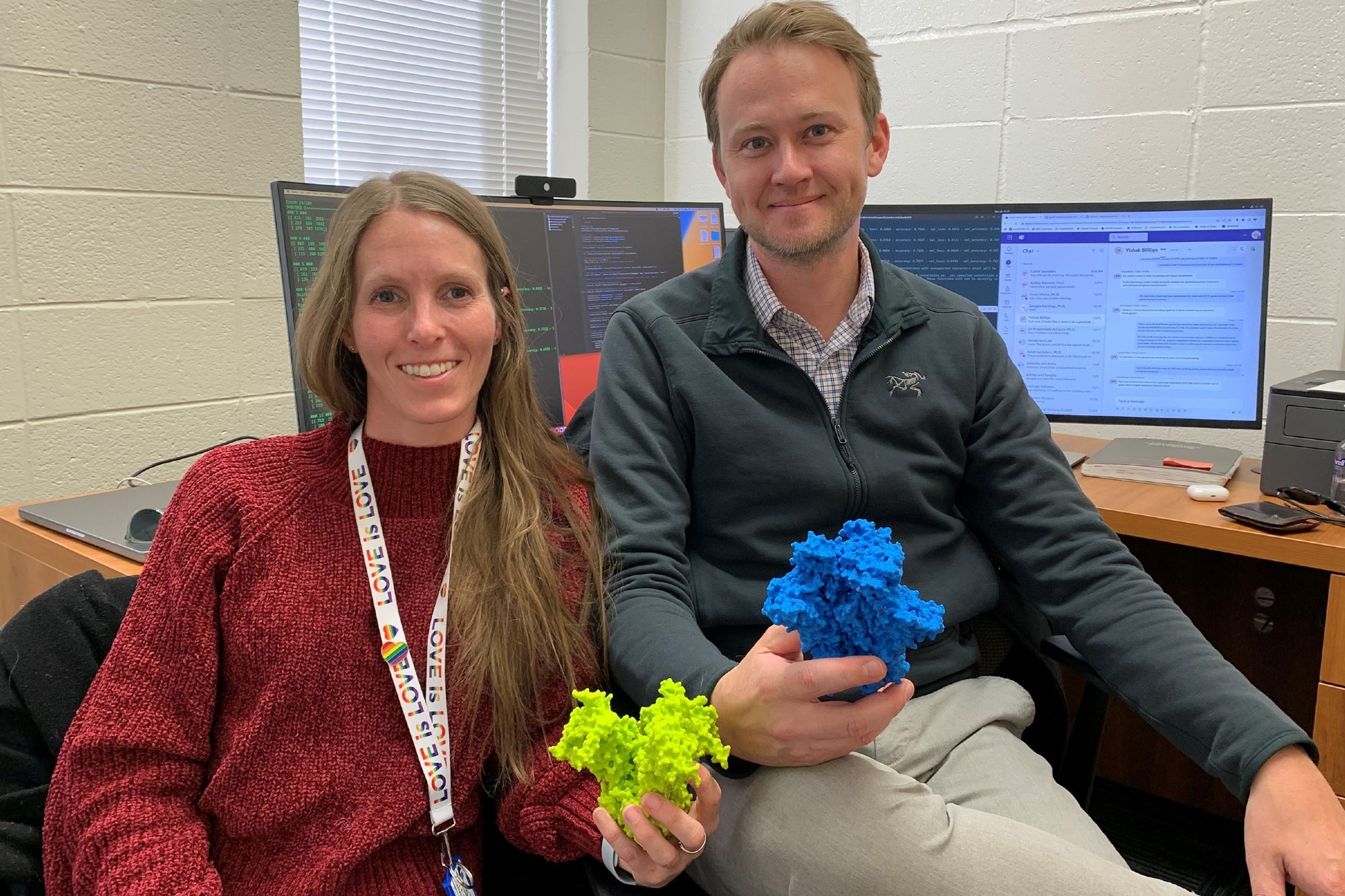As the HIV virus approaches a human cell to dock and potentially deliver its lethal genetic code, there is a remarkably brief moment during which a tiny portion of its surface undergoes a rapid opening, initiating the infection process.
 Postdoctoral researcher Ashley Bennett (left) and Associate Professor Rory Henderson of the Duke Human Vaccine Institute with 3D printed models of the molecules they study on the HIV virus.Image Credit: Duke Human Vaccine Institute
Postdoctoral researcher Ashley Bennett (left) and Associate Professor Rory Henderson of the Duke Human Vaccine Institute with 3D printed models of the molecules they study on the HIV virus.Image Credit: Duke Human Vaccine Institute
HIV Discovery | Check This Out
Duke Postdoctoral researcher Ashley Bennett describes an HIV discovery they hope will bring a vaccine across the finish line. Video Credit: Duke Human Vaccine Institute
Observing this structure's rapid opening and closing in mere millionths of a second is providing researchers at the Duke Human Vaccine Institute (DHVI) with new insights into the virus's surface. These insights could pave the way for the development of broadly neutralizing antibodies for an AIDS vaccine.
The ability to attach an antibody specifically to this small structure, preventing its rapid opening, is deemed crucial. The findings of this research were published on February 2nd, 2024, in Science Advances.
Since the envelope glycoprotein structure is essential to the virus's ability to bind to the CD4 T-cell receptor, AIDS researchers have been attempting to understand it for years. While many components of the envelope are always changing to elude the immune system, vaccine immunogens are made to remain largely unchanged.
Everything that everybody, including our group, had done to try to stabilize this (structure) is unlikely to block the movement we observed in this study. It’s not that we did anything wrong based on what we knew; it's just that we didn’t know it moves this way until now.”
Rory Henderson, Study Lead Author, Structural Biologist and Associate Professor, Medicine, Duke University Medical Center
Ashley Bennett, a Postdoctoral Researcher and study co-author, provides a play-by-play: The virus first clings to the host cell's CD4 receptor as it searches for the optimal attachment site on a human T-cell. The envelope structure then opens as a result of that connection, revealing a co-receptor binding site- “and that’s the event that actually matters.”
Once both molecules of the virus are bound to the cell membrane, the process of injecting viral RNA can begin.
Henderson says, “Because HIV-1 is an integrating virus, blocking this process completely is essential to prevent infection.”
Bennett agrees, “If you get infected, you’ve already lost the game because it’s a retrovirus.”
The moving structure they found protects the sensitive co-receptor binding site on the virus.
Henderson says, “It’s also a latch to keep it from springing until it's ready to spring.”
Keeping it latched with a specific antibody would stop the process of infection.
Bennett and Henderson used an electron accelerator at the Argonne National Laboratory outside of Chicago, which produces X-Rays at wavelengths that can resolve as small as a single atom, to see the viral components in various states of open, closed, and in-between. But there is a lot of demand for this pricey shared equipment. Three 120-hour blocks of synchrotron time were given to the AIDS researchers so they could try to collect as much data as they could in long sessions.
Basically, you just go until you can’t anymore.”
Ashley Bennett, Postdoctoral Researcher and Study Co-Author, Duke Human Vaccine Institute, Duke University Medical Center
This work suggests that previous research elsewhere had suggested antibodies were being designed for the incorrect shapes on the virus, and that was probably true.
The question has been ‘why, when we immunize, are we getting antibodies to places that are supposed to be blocked? Part of the answer should lie in this particular structure and its shape-shifting. It’s the interplay between the antibody binding and what this shape is that’s really critical about the work that we did. And that led us to design an immunogen the day we got back from the first experiment. We think we know how this works.”
Rory Henderson, Study Lead Author, Structural Biologist and Associate Professor, Medicine, Duke University Medical Center
Source:
Journal reference:
Bennett, L. A., et al. (2024) Microsecond dynamics control the HIV-1 Envelope conformation. Science Advances. doi.org/10.1126/sciadv.adj0396